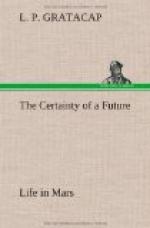My father had read Schiaparelli’s announcements with absorbed interest. They fed his burning fancies as to the extension of our present life, and offered him a sort of scientific basis (without which he was inclined to view all eschatology as superficial) for the belief that we may attain in some other planet an actual prolonged second existence.
His great reverence for Sir William Herschell was indisputable. He quoted Herschell’s own words with appreciation. These pregnant sentences were as follows:
“The analogy between Mars and the earth is perhaps by far the greatest in the whole solar system. Their diurnal motion is nearly the same, the obliquity of their respective ecliptics not very different; of all the superior planets the distance of Mars from the sun is by far the nearest, alike to that of the earth; nor will the length of the Martial year appear very different from what we enjoy when compared to the surprising duration of the years of Jupiter, Saturn and the Georgian Sidus. If we then find that the globe we inhabit has its polar region frozen and covered with mountains of ice and snow, that only partially melt when alternately exposed to the sun, I may well be permitted to surmise that the same causes may probably have the same effect on the globe of Mars; that the bright polar spots are owing to the vivid reflection of light from frozen regions; and that the reduction of these spots is to be ascribed to their being exposed to the sun.”
“In the light of these larger analogies,” my father would continue, “why are we not further permitted to conclude that there is a more intimate and minute correlation. Why can not we predicate that under similar climatic and atmospheric vicissitudes, with a very probably similar or identical origin with our globe, this planet Mars, now burning red in the evening skies, possesses life, an organic retinue of forms like our own, or at least involving such primary principles as respiration, assimilation and productiveness, as would produce some biological aspects not extremely differing from those seen in our own sphere.
“If we imagine, as we are most rationally allowed to, that Mars has undergone a progressive secularization in cooling, that contraction has acted upon its surface as it has on ours, that water has accumulated in basins and depressed troughs, that atmospheric currents have been started, that meteorological changes in consequence have followed, and that the range of physical conditions embraces phases naturally very much like those that have prevailed in our planet, how can it be intelligently questioned that from these very identical circumstances, an order of life has not in some way arisen.”
My father had an interesting habit of snapping his fingers on both hands together over his head when he declaimed in this way, always circling about the room in a rapid stride. I remember he stopped in front of me and continued in a strain something like this:




